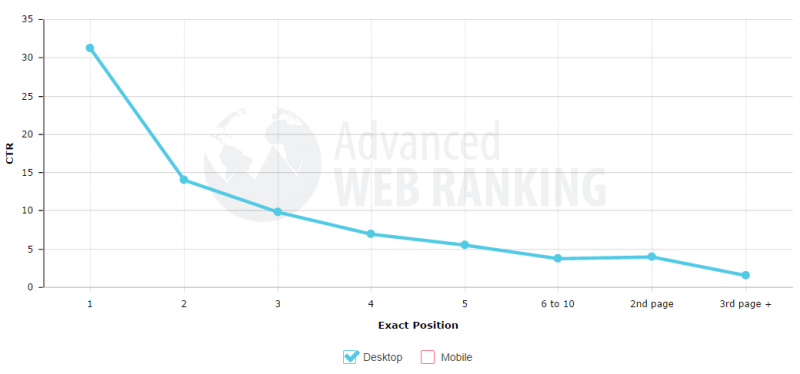You’ve built outstanding on-page content, optimised all of your page elements for your target keywords and built links that took you all the way to the first position for your target keywords.
You’re ranked first, and your business is doing well as a result. Calls are coming in, deals are being closed and sales are growing at a faster pace than ever. From an SEO standpoint, what should you do next?
Ask some SEOs and they’ll recommend expanding your target keyword list to generate more traffic. This is a great idea, but it’s not the only way to further grow your SEO results. A much simpler strategy is to focus on getting more traffic from your existing organic search rankings.
How can you do this? Through clickthrough rate, or CTR. CTR is the percentage of users that click on your website’s listing in Google’s search results. Usually, but not always, the highest ranked result for any given keyword on Google gets the highest CTR and the most traffic.
CTR is expressed as a percentage. A 20% clickthrough rate means that 20% of the people that search for your target keyword (even if your listing is below the fold) click on your result. A high CTR means your listing is highly relevant to the user’s search query.
Data from Advanced Web Ranking shows that the first result for any search term receives, on average, 31.24% of the clicks. The second gets 14.04%, the third 9.85% and the sixth to 10th results just 3.73 per cent. The entire third page or organic listings gets just 1.6% of all clicks.
This means that if you’re in first, you can expect to get twice as much traffic as your competitor in the second position for the same keyword, and more than three times as much as the listing in third. But there’s more to CTR than just the position you rank in — much more, in fact.
As any AdWords advertiser can tell you, searchers don’t just click on search results because of where they are on the first page of Google’s results. They also click based on how relevant the result is to their query. The more relevant your page is, the higher its CTR will typically be.
From an SEO perspective, there are three variables that you can optimise to improve your CTR in organic search. These three variables are your page title, your meta description and the URL that’s displayed in the search results for each page of your website.
Below, we’ve included an example of how our website’s page title, meta description and URL appear in Google’s search results:
As you might have noticed, these three factors (with the exception of meta description, which is less relevant for SEO than many people believe) match Google’s organic ranking factors.
By making small changes to your title, meta description and page URL, you can achieve a better CTR from organic search and get more traffic for your target keywords. This means that even if you rank third for your target keyword, you can “outrank” the top result in terms of total traffic.
Interested in increasing your organic search CTR? Below, we’ve explained how you can modify these three variables to increase your organic search clickthrough rate and earn a higher share of the impressions your website already receives.
Step One: Optimise your page title
Your page title is the first thing most people will see when searching for your business. It’s the big, bold text that Google adds to the top of your website’s search engine listing. If you’re using WordPress for your website, you can modify your page title using the SEO Ultimate plugin.
If your website is a static HTML and CSS page, you can use the <title> tag to configure your title text. Since your title is the first part of your search listing that users will notice, it has to achieve several things at once:
- Inform users about what your website offers
- Give users a reason to click through to your website
- Include your target keyword, for on-page SEO purposes
From an SEO perspective, it’s best to keep your target keyword as close to the beginning of the page title as possible. Using your target keyword near the beginning of your title also makes it easier for users to quickly understand what your page is about, improving CTR.
Here’s another example of our company’s search engine listing, this time with a red line to show the title element:
You can see that this listing meets all of the criteria above. It tells users exactly what our website offers, which is SEO services. It gives them a reason to click by mentioning our reliability. It also includes our target SEO keyword, right at the beginning of the title.
Here’s another example, this time for the keyword “airport taxis in manchester”. The title has the target keyword right at the beginning, with a key benefit (the ability to compare quotes and book online) just after the target search keyword:
This keyword-benefit title format is a great option for achieving a strong balance between SEO and CTR. Since your keyword is right at the beginning of your title, your listing is highly relevant and optimised for rankings. Since a benefit is included, users are far more motivated to click.
Step Two: Optimise your meta description
The second element we’ll look at optimising is your page’s meta description. This is the snippet of text that Google displays below your page’s title and URL in the search results. It’s usually a short description of the page that describes the product, service or information you offer.
The meta description is one of the most misunderstood aspects of SEO. According to Google, it doesn’t play a major role in helping your page rank for its target keyword. It does, however, play a huge role in determining your page’s clickthrough rate from organic search.
Many website owners don’t add meta descriptions to their pages. If your page doesn’t have its own meta description, Google will generate one automatically by taking a snippet of text from your page that it thinks is most relevant for each keyword.
Optimising your meta description can double, or even triple, your listing’s CTR. If your page has no meta description at all, merely adding one can cause the number of people that click on your listing to skyrocket, resulting in more traffic, more leads and more sales.
Like a good page title, a good meta description needs to do several things at once:
- Inform users about what to expect after they reach your page
- Mention a benefit, preferably one that’s unique to your listing
- Finish with a call to action that makes users want to click
Here’s our company’s search engine listing again, this time with all of the three above elements highlighted:
Highlighted in red is information on what users can expect after they click through — in this case, a description of the company. In yellow, a unique benefit of our listing. In green, a call to action that gives users a clear motivation to click through to our website.
This description, benefit, call to action formula works very well for creating a meta description that improves your organic search CTR. It’s also versatile enough to work for nearly any page type, from an informational website to a commercial page for a local business.
Step Three: Use a short, highly relevant page URL
The final element in a great organic search listing is your page’s URL. Your URL typically has the smallest impact on clickthrough rate, but it’s still makes enough of a difference to make it worth optimising.
On a domain level, there’s very little you can do to optimise your URL. However, on a page by page level, it’s best to make sure your URL includes your target keyword, is short enough that it’s not distracting for users, and doesn’t conflict with your meta description or page title.
Here’s an example of an effective page URL, courtesy of Capterra:
It’s short, simple and includes the target SEO keywords. It also clearly describes what’s on the page and doesn’t conflict with the page title or meta description. For the most part, a page URL that’s optimised for SEO is usually also ideal from a CTR perspective.
Is your website optimised for organic search CTR?
It’s easy to prioritise SEO for your website, all while forgetting that optimising for CTR can also help you generate more traffic. Is your website optimised for organic CTR? If your titles or meta descriptions are lacking, follow the steps above to improve your CTR and generate more traffic.







 (
( (
(
 Like us on Facebook
Like us on Facebook
 Follow us on Twitter
Follow us on Twitter
 Connect on LinkedIn
Connect on LinkedIn